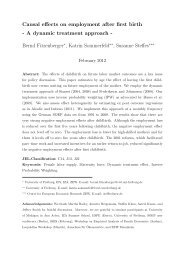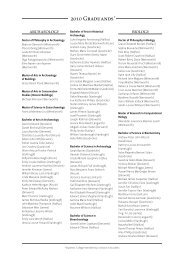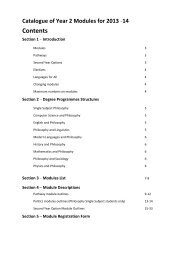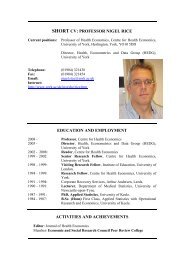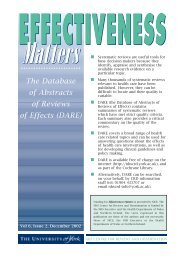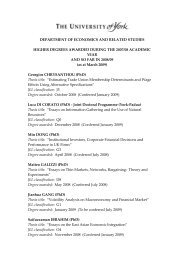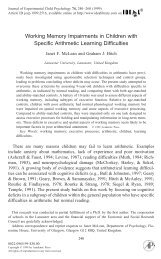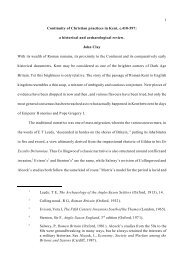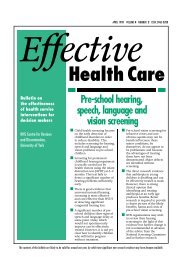GeloriniPhD (PDF , 6973kb) - University of York
GeloriniPhD (PDF , 6973kb) - University of York
GeloriniPhD (PDF , 6973kb) - University of York
Create successful ePaper yourself
Turn your PDF publications into a flip-book with our unique Google optimized e-Paper software.
Abstract<br />
. 17 .<br />
ABSTRACT<br />
In tropical Africa the palaeoecological visibility <strong>of</strong> (pre)historical human impact on natural ecosystems is strongly<br />
impeded by a dominant signature <strong>of</strong> climate change at decade-to-century and millennial scales. Better knowledge <strong>of</strong><br />
the relative magnitude <strong>of</strong> past human impact is, however, instrumental to properly assess the resilience, and recovery<br />
potential, <strong>of</strong> Africa’s natural ecosystems. In this study, we combined taxonomic, ecological and palaeoecological<br />
approaches to validate fossil non-pollen palynomorphs (NPPs), i.e. non-pollen micro-remains from fungi and selected<br />
groups <strong>of</strong> algae, vascular plants and invertebrates, as palaeoenvironmental indicators for climate change and human<br />
impact on East African ecosystems.<br />
We first studied fossil NPP assemblages from the sediment record <strong>of</strong> Lake Challa, a deep crater lake located near<br />
Mt. Kilimanjaro, with the aim to assess the taxonomic diversity <strong>of</strong> well-defined East African NPPs over the past 25,000<br />
years, and to exploit their stratigraphic turnover during major climate and environmental changes as a guide to their<br />
potential as palaeoecological indicators. By comparing 61 fungal spore types with selected pollen curves <strong>of</strong> common<br />
African trees and herbs, and with independent proxies <strong>of</strong> regional climate (temperature and rainfall) history, we revealed<br />
specific habitat requirements <strong>of</strong> individual NPP taxa. Particularly, changing habitat conditions at the Glacial-to-Holocene<br />
transition (ca. 11,500 cal. yr BP) stand out as the most important event in the distribution <strong>of</strong> fungal spore types such as<br />
Curvularia, Coniochaeta cf. ligniaria, Acrodyctis, Tetraploa aristata, cf. Byssothecium and de types HdV-1032 and HdV-1033.<br />
To expand our knowledge <strong>of</strong> NPP taxonomic richness in East African lake sediments, we then explored modern<br />
NPP assemblages in recently deposited surface sediments <strong>of</strong> 20 small crater lakes in western Uganda, located along<br />
environmental gradients <strong>of</strong> vegetation (moist evergreen and semi-deciduous forest, wooded and open grass savannah),<br />
land use (pastoralism, crop agriculture, plantations) and lake characteristics (basin morphometry, water chemistry and<br />
aquatic production). This resulted in a comprehensive inventory <strong>of</strong> 265 distinct morphotypes, <strong>of</strong> which 28% could<br />
be identified at the species, genus or family level. Focus on the taxonomy <strong>of</strong> these micr<strong>of</strong>ossils resulted in taxonomic<br />
descriptions <strong>of</strong> 187 morphotypes, accompanied by high-resolution photographs and ecological information, when<br />
available.<br />
By the year 2100, land-use change will probably be the principal driver <strong>of</strong> overall biodiversity loss, particularly<br />
in the tropics where agricultural conversion <strong>of</strong> natural ecosystems and the overall intensity <strong>of</strong> anthropogenic land use<br />
continues unabated. Because <strong>of</strong> poor knowledge <strong>of</strong> the taxonomic diversity <strong>of</strong> tropical fungi and their response to<br />
habitat changes, however, mycological tools to estimate the effects <strong>of</strong> various land-use practices on fungal diversity are<br />
scarce. We used a statistical mixed-model analysis based on the Akaike Information Criterion (AIC) to comprehensively<br />
evaluate the response <strong>of</strong> African fungal spore diversity (richness and evenness) to agricultural impact at the landscape<br />
scale. For this study we used fungal spore assemblages extracted from the recently deposited surface sediments <strong>of</strong> 24<br />
western Ugandan crater lakes, assumed to reflect fungal communities presently living in (mostly) terrestrial habitats<br />
within each lake’s crater basin. This analysis revealed that the richness <strong>of</strong> fungal spore types was inversely related to the<br />
percent area <strong>of</strong> agricultural land-cover types in human-impacted crater basins. The evenness <strong>of</strong> fungal spore diversity<br />
appeared to be related to size characteristics (i.e. the crater area/lake area ratio) <strong>of</strong> the pristine crater basins, tentatively<br />
suggesting higher biomass stability in small lakes with a relatively large catchment area. These results point to the<br />
possible threat <strong>of</strong> fungal species loss, when natural ecosystems are progressively exposed to anthropogenic land use.<br />
Finally, two paired 200-yr NPP records from relatively small, shallow crater lakes (the presently undisturbed Lake<br />
Chibwera and the human-disturbed Lake Kanyamukali) in western Uganda were studied to distinguish signals <strong>of</strong> fungal<br />
response to site-specific historical human impact from the common impacts <strong>of</strong> regional climate variability. Both NPP<br />
records registered a strong parallel signature <strong>of</strong> fluctuations in lake level and moisture balance, mainly reflected in the<br />
abundances <strong>of</strong> the fungal spore type Coniochaeta spp., aquatic pollen types (Typha, Nymphaea and Cyperaceae) and<br />
algal colonies/coenobia (Botryococcus). Moreover, the marked presence <strong>of</strong> some obligate coprophilous ascomycetes,



